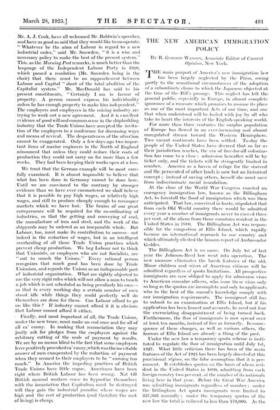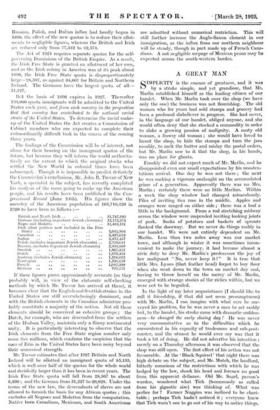THE NEW AMERICAN IMMIGRATION POLICY
By R. GORDON WASSON, Associate Editor of Current Opinion, New York.
THE main purport of America's new immigration law has been largely neglected by the Press, ,owing partly to the sensational circumstances of the adoption of a subordinate clause to which the Japanese objected at the time of the Bill's passage. This neglect has _left the general public, especially in Europe, in almost complete ignorance of a measure which promises to assume its place as one of the most important Acts of our time, and one that when understood will be hailed with joy by all who as one of the most important Acts of our time, and one that when understood will be hailed with joy by all who take to heart the interests of the English-speaking world.
For more than three centuries the surplus population of Europe has flowed in an ever-increasing and almost unregulated stream toward the Western Hemisphere.
Two vacant continents have been settled. To-day the people of the United States have decreed that so far as their jurisdiction reaches, the era of free-for-all coloniza- tion has come to a close : admission hereafter will be by ticket only, and.the tickets will be sti ingently limited in number. America as a haven of refuge for the starved and the persecuted of other lands is now but an historical concept ; instead of saving others, herself she must save from indiscriminate racial inundation.
At the close of the World War Congress enacted an emergency immigration law, known as the Dillingham Act, to forestall the flood of immigration which was then anticipated. That law, conceived in haste, stipulated that from each Old World country there would be admitted every year a number of immigrants never to exceed three per cent. of the aliens from those countries resident in the United States in 1910. The Dillingham Act was respon- sible for the congestion at Ellis Island, which rapidly became an international reproach to our country and which ultimately elicited the famous roport of Ambassador Geddes.
The Dillingham Act is no more. On July 1st of last year the Johnson-Reed law went into operation. The new measure eliminates the harsh features of the old.
Minor children and wives of -American citizens will be admitted regardless of quota limitations. All prospective immigrants are now obliged to apply for admission visas to American consular officers, who issue these visas only so long as the quotas are incomplete and only to applicants who to the best of the consul's knowledge comply with our immigration requirements. The immigrant still has to submit to an examination at Ellis Island, but if his application has been honest and accurate, he need not fear the excruciating disappointment of being turned back. Furthermore, the flow of immigrants Is now spread over at least ten months, instead of five as formerly. In conse- quence of these changes, as well as various others, the 'horrors of Ellis Island are already a thing of the past: Under the new law a temporary quota scheme is insti- tuted to regulate the flow of immigration until July 1st, 1927. What little criticism there has been of the main -features of the Act of 1924-has been largely directed at this provisional regime, on the false assumption that it is per- manent. It establishes quotas on the basis of aliens resi- dent in the United States in 1890, admitting from each foreign country two per cent. of the number of its nationals living here in that year. Before the Great War America was admitting. immigrants regardless of number ; under the Dillingham Act quota immigrants were limited to 357,803 annually; under the temporary quotas of the new law the total is reduced to less than 170,000. As the Russian, Polish, and Italian influx had hardly begun in 1890, the effect of the new quotas is to reduce their allot- ments to negligible figures, whereas the British and Irish are reduced only from 77,342 to 62,574.
The Act of 1924 requires separate quotas for the self- governing Dominions of the British Empire. As a result, the Irish Free State is granted an allotment of her own, and as the Irish colony in America was at its peak about 1890, the Irish Free State quota is disproportionately large-28,567, as against 34,007 for Britain and Northern Ireland. The Germans have the largest quota of all- 51,227.
But the basis of 1890 expires in 1927. Thereafter 150,000 quota immigrants will be admitted to the United States each year, and from each country in the proportion that that country has contributed to the national racial strain of the United States. To determine the racial make- up of the United States the Act creates a Commission of Cabinet members who are expected to complete their extraordinarily difficult task in the course of the coming three years.
The findings of the Commission will be of interest, not alone for their bearing on the immigrant quotas of the future, but because they will inform the world authorita- tively on the extent to which the original stocks who settled the New World in colonial times have been submerged. Though it is impossible to predict definitely the Commission's conclusions, Mr. John B. Trevor of New York, a specialist in the subject, has recently completed his analysis of the races going to make up the American people, and his results have been published in the Con- gressional Record (June 24th). His figures show the ancestry of the American population of 105,710,620 in 1920 to have been as follows :—
British and North Irish .. 51,747,680 German (including important Jewish elements) 12,173,374 Negro and Mulatto .. 11,463,131 Irish (that portion now included in the Free
State) .. . • . • •
5,063,966 Canadian .. 3,497,053 Italian .. . 3,472,457 Polish (includes important Jewish elements) .. 2,759,041 Russian (includes important Jewish elements) 2,434,669
Swedish .. . • • • • • •
1,867,352
Dutch .. .. .. • •
1,678,463
Austrian (includes Jewish elements) • •
1,316,093
Norwegian .. • • .. • •
1,250,659
French .. • • • • ..
1,082,399
Mexican .. • • • • • • • •
799,271
If these figures prove approximately accurate (as they probably will, in view of the elaborate self-checking methods by which Mr. Trevor has arrived at them), it becomes clear that the English and Scottish strains in the United States are still overwhelmingly dominant, and with the British elements in the Canadian admixture pro- bably constitute a majority of the nation. Not all these elements should be conceived as cohesive groups ; the Dutch, for example, who are descended from the settlers of the Hudson Valley, maintain only a flimsy sentimental unity. It is particularly interesting to observe that the Irish elements from the Free State region number only some five millions, which confirms the suspicion that the sons of Erin in the United States have been noisy beyond their numerical strength.
Mr. Trevor estimates that after 1927 Britain and North Ireland will be allotted an immigrant quota of 85,135, which is well over half of the quotas for the whole world and decidedly larger than it has been in recent years. The Irish Free State quota will fall from 28,567 to about 8,330 ; and the German from 51,227 to 20,028. Under the terms of the new law, the descendants of slaves are not allowed to furnish the basis for any African quotas ; this excludes all Negroes and Mulattos from the computation. Native born Canadians, Mexicans, and South Americans are admitted without numerical restriction. This will still further increase the Anglo-Saxon element in our immigration, as the influx from our northern neighbour will be steady, though in part made up of French Cana- dians. A not negligible seepage of Mexican peons may be expected across the south-western border.















































 Previous page
Previous page